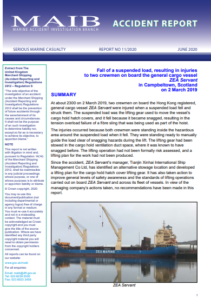UK MAIB issued an investigation report on the fall of a suspended load, resulting in injuries of two crewmen onboard the general cargo vessel ZEA Servant, in Campbeltown, Scotland, on 2 March 2019. The two crewmen were struck by the falling lifting gear and were injured because they were standing in the hazardous fall zone beneath the suspended load.
The incident
[smlsubform prepend=”GET THE SAFETY4SEA IN YOUR INBOX!” showname=false emailtxt=”” emailholder=”Enter your email address” showsubmit=true submittxt=”Submit” jsthanks=false thankyou=”Thank you for subscribing to our mailing list”]
At about 2300 on 2 March 2019, two crewmen onboard the Hong Kong-registered general cargo vessel ‘ZEA Servant’ suffered injury when a suspended load fell and struck them.
The suspended load was the lifting gear used to move the vessel’s cargo hold hatch covers, and it fell because it became snagged, resulting in the tension overload failure of a fibre sling that was being used as part of the hoist.
The injuries occurred because both crewmen were standing inside the hazardous area around the suspended load when it fell.
They were standing ready to manually guide the load clear of snagging hazards during the lift.
The lifting gear had been stowed in the cargo hold ventilation duct space, where it was known to have snagged before.
The lifting operation had not been formally risk assessed, and a lifting plan for the work had not been produced.
Conclusions
- The suspended load fell because the fibre sling being used to lift it failed under tension. This happened when the load became snagged and the crane was not stopped in time to prevent overloading of the sling.
- The two crewmen were struck by the falling lifting gear and were injured because they were standing in the hazardous fall zone beneath the suspended load.
- The injured crewmen were standing in the hazardous area because they wanted to be on hand to guide the load and free any snags. They probably underestimated the risks they were taking because they had done the job before and the load had previously snagged without incident.
- ZEA Servant was not fitted with a dedicated storage arrangement for the cargo hatch lifting gear, and the practice of placing it on pallets in the ventilation duct space was not appropriate, due to the snagging hazards.
- A formal task-specifc risk assessment and lifting plan had not been carried out for the handling of the cargo hold hatch cover lifting gear.
- The SWL of the fibre sling that parted was sufficient for the lift, but it should not have been used and should have been discarded because its material condition was poor and its identification markings were illegible. The vessel did not have a comprehensive lifting equipment register; the onboard records did not include all of the loose lifting gear.
Actions taken
ZEA Servant’s manager, Tianjin Xinhai, has:
- Identified an alternative and more suitable location to stow the cargo hold hatch cover lifting gear and developed a lifting plan for its removal and re-stowing.
- Notified its feet of the importance of crew safety awareness, including the need for self-protection measures and safe positioning during lifting operations.
- Notified its feet of the importance of the safety brief and the responsibilities of those supervising lifting operations.
- Undertaken a review of the vessel’s safety management system.
- Provided additional safety training to ZEA Servant’s crew on the procedure to open hatches and the inspection of lifting equipment.
- Issued a feet circular requiring checks to lifting equipment, including SWL of each component, certifcation and the condition of fbre slings.
- Required shore managers to inspect operational safety of crew.
Explore more herebelow:































































